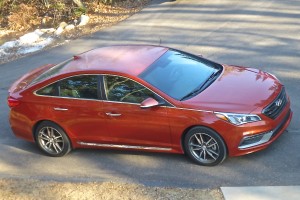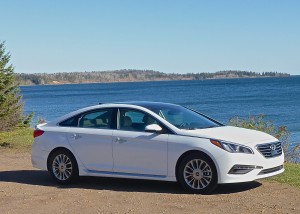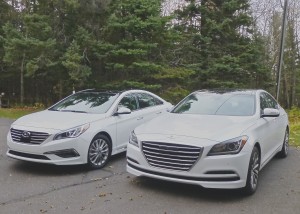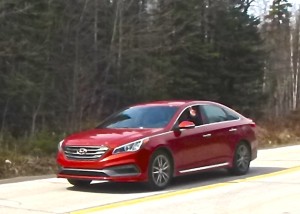Refined, Restyled, Sonata Remains Midsize Icon
By John Gilbert
When Hyundai redesigned its midsize Sonata for the 2011 model year, a trusty and useful caterpillar was transformed into a stunning and award-winning butterfly, and the overall success of the Sonata gave the South Korean company an instant signature vehicle.
Boasting a sketchpadful of curvaceous contours, it also was blessed with new levels of high-grade steel — from its own steel plant — for lightness without compromising safety, and an all-new 2.4-liter 4-cylinder engine that bristled with sporty power, thanks to a futuristic high-pressure/low-temperature but costly direct injection system. Hyundai hooked it up to its own corporate 6-speed automatic transmission that was built in-house and was lighter and smaller than the less-efficient aftermarket 5-speed transmissions used by other companies.
All those features gave the Sonata a technical edge on its competition almost before suddenly the Accord, Camry, Mazda6, Fusion, Malibu and Altima knew that more than midsize room and sportiness were being challenged. Despite the edge in technology and fuel efficiency, the Sonata also came in several thousand dollars lower in sticker price. As if to prove that everything could be star-crossed into one vehicle, the 2011 Sonata was U.S. built, in a new plant in Montgomery, Ala., while its engine plant was 50 miles up the freeway.
I thought the Sonata was the most significant car introduced for 2011, and I mentioned to a Hyundai engineer back then that the car had all the ingredients to be the perfect contemporary vehicle. The only thing lacking, I suggested, was in steering and suspension, both for firmer handling, and also because they could be coordinated for the true sporty handling the car deserved. Those would be the toughest achievements, and take the longest to attain.
Still, self-teaching itself to create the ingredients was substantial enough that Hyundai could spread its new-found technical wealth around to its other vehicles. Within a couple of years, all its smaller 4s, larger V6es, and new V8s benefitted by direct injection and the in-house transmission.
A new entry-luxury Genesis was another part of Hyundai’s upsurge, which is a factor in the new-for-2015 scenario. A thoroughly renovated Genesis has just arrived for 2015, with smoothly flowing refinement and the proper room and features of a luxury sedan, with proper handling, having learned a few suspension tricks from consultation with Lotus engineers. It all works amazing well.
But before anyone could suggest the bargain-luxury Genesis had become Hyundai’s new signature model, the redesigned 2015 Sonata arrived. On the outside, the Sonata trades in the polarizing contours for a more formal look, which Hyundai calls “Fluidic Sculpture.” The new Sonata actually resembles the new Genesis more than it does the outgoing Sonata, leaving those curvy contours to remain distinctive for the 2011-14 Sonata, and replacing them with sweeping lines and a new, upright, Genesis-like grille.
“Instead of adding more flair, we put straighter lines on the sides, so it looks more like an athlete in a tight suit,” said Christopher Chapman, chief designer of the car.
The resemblance is striking if you park a Sonata alongside a Genesis. You could easily mistake one for the other, although the Genesis never looks like a bargain-priced midsize, even if the new Sonata takes on entry-luxury stature. Inside, the Sonata’s interior has been refined and restyled to appeal to every taste. But the real trick is underneath that exterior and interior.
Hyundai will never say that Lotus helped design the suspension of the new Genesis, but from vastly tightened and responsive steering and the far more coordinated suspension of both cars, we can theorize that Hyundai engineers applied some Lotus ideas to the rear-drive Genesis, then reconfigured it to revolutionize the front-wheel-drive Sonata’s feel.
In the corporate scheme of things, Kia gets joint-venture use of Hyundai engines and transmissions. Kia builds the Optima, a very slick parallel to the Sonata. The Optima has always had the benefit of more sporty touches, while the Sonata has been more, uh, pedestrian.
 But the new Sonata, which starts with the same reliable and peppy 2.4-liter 4 standard, adds a couple of variants for 2015. A Sport version has the reduced-displacement 2.0-liter engine, which is turbocharged and direct-injected for a large boost in power, and the 6-speed automatic gets steering-wheel paddle controls for manual shifting. The steering wheel has a flat-bottom shape, similar to the Volkswagen Golf GTI, for those who might not push the Sonata Sport hard enough to appreciate its improved dynamics.
But the new Sonata, which starts with the same reliable and peppy 2.4-liter 4 standard, adds a couple of variants for 2015. A Sport version has the reduced-displacement 2.0-liter engine, which is turbocharged and direct-injected for a large boost in power, and the 6-speed automatic gets steering-wheel paddle controls for manual shifting. The steering wheel has a flat-bottom shape, similar to the Volkswagen Golf GTI, for those who might not push the Sonata Sport hard enough to appreciate its improved dynamics.
In addition, the Sonata is offered with Hyundai’s very peppy little 1.6-liter 4, lifted from the Accent, Elantra, and even the newly revised Tucson SUV in a hyper-economy model. Turbocharging makes it more than just an economy car. In a matter of weeks, Hyundai also will present a new hybrid Sonata.
After driving several models at the Sonata introduction, I spent a week with a glistening white Sonata Limited, and more recently was able to spend a week with a Sonata Sport. It was a unique off-red color, called “urban sunset,” and it came with the 2.0 turbocharged engine that produces 245 horsepower at 6,000 RPMs, and 260 foot-pounds of torque, which is not only a lot of punch, but peaks and remains constant all the way from 1,350 to 4,000 RPMs.
The car carved through curves and tight corners with precision, amplified by the paddle-shifting, which gives the Sonata part of its new personality. Greatly appreciated, too, is the coordination between the refined power steering and the new suspension — both tweaked to sport settings.
With stability management and traction control, the latest brake-force distribution and brake assist, plus all the high-tech features, such as blind-spot detection, rear cross-traffic alert, leather seats, automatically dimming rearview mirror, and Bluetooth and Blue Link connectivity, the Sonata Sport listed at $29,510. Definitely a bargain, considering the features and refinement contained within.
“More horizontal architectural lines create the reality of more control,” said Chapman, inadvertently describing the juncture of appearance with reality. “It’s built with safety, but it’s intuitive and comfortable while being safe. If we can turn safety into something sexy, the whole industry will be better off.”
Hard to quarrel with that. It’s all part of living up to its new image, although the explanation, impressive as it is, might still fall short of explaining how the previous generation Sonata had all the ingredients to be a great car, while the new one puts all those ingredients in place to reach that plateau of being a truly great car.





 John Gilbert is a lifetime Minnesotan and career journalist, specializing in cars and sports during and since spending 30 years at the Minneapolis Tribune, now the Star Tribune. More recently, he has continued translating the high-tech world of autos and sharing his passionate insights as a freelance writer/photographer/broadcaster. A member of the prestigious North American Car and Truck of the Year jury since 1993. John can be heard Monday-Friday from 9-11am on 610 KDAL(www.kdal610.com) on the "John Gilbert Show," and writes a column in the Duluth Reader.
John Gilbert is a lifetime Minnesotan and career journalist, specializing in cars and sports during and since spending 30 years at the Minneapolis Tribune, now the Star Tribune. More recently, he has continued translating the high-tech world of autos and sharing his passionate insights as a freelance writer/photographer/broadcaster. A member of the prestigious North American Car and Truck of the Year jury since 1993. John can be heard Monday-Friday from 9-11am on 610 KDAL(www.kdal610.com) on the "John Gilbert Show," and writes a column in the Duluth Reader.